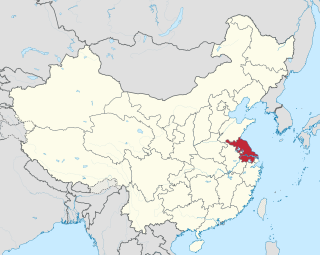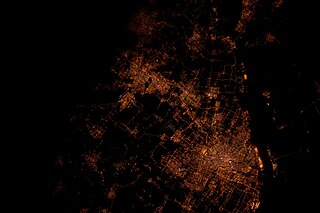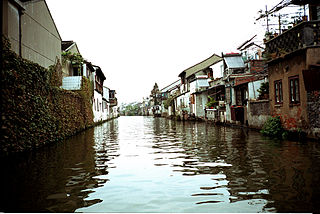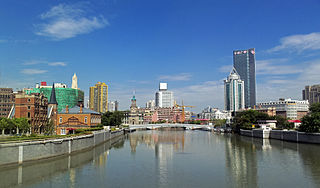
Jiangsu, is an eastern-central coastal province of the People's Republic of China. It is one of the leading provinces in finance, education, technology and tourism, with its capital in Nanjing. Jiangsu is the third smallest, but the fifth most populous and the most densely populated of the 23 provinces of the People's Republic of China. Jiangsu has the highest GDP per capita of Chinese provinces and second-highest GDP of Chinese provinces, after Guangdong. Jiangsu borders Shandong in the north, Anhui to the west, and Zhejiang and Shanghai to the south. Jiangsu has a coastline of over 1,000 kilometres (620 mi) along the Yellow Sea, and the Yangtze River passes through the southern part of the province.

The Yangtze River Delta or YRD is a triangle-shaped metropolitan region generally comprising the Wu Chinese-speaking areas of Shanghai, southern Jiangsu province and northern Zhejiang province. The area lies in the heart of the Jiangnan region, where Yangtze River drains into the East China Sea. The urban build-up in the area has given rise to what may be the largest concentration of adjacent metropolitan areas in the world. It covers an area of 99,600 square kilometres (38,500 sq mi) and is home to over 115 million people as of 2013, of which an estimated 83 million is urban. If based on the greater Yangtze River Delta zone, it has over 140 million people in this region. Having a fertile soil, the Yangtze River Delta abundantly produces grain, cotton, hemp and tea. In 2018, the Yangtze River Delta had a GDP of approximately US$2.2 trillion, about the same size as Italy.

Taizhou is a prefecture-level city in central Jiangsu province in eastern China. Situated on the north bank of the Yangtze River, it borders Nantong to the east, Yancheng to the north and Yangzhou to the west.

Suining County is under the administration of Xuzhou, Jiangsu province, China; it is the southernmost county-level division of Xuzhou and borders the prefecture-level cities of Suqian to the east and Suzhou of Anhui to the south and west.

Yizheng is a county-level city under the administration of the prefecture-level city of Yangzhou, Jiangsu province, China, with a population of about 600,000 (2007). It borders the prefecture-level divisions of Chuzhou (Anhui) to the north, Nanjing to the west, and Zhenjiang to the south.
Port of Suzhou is the collective name of three ports around the city of Suzhou, Jiangsu Province, China. The three ports are located in Zhangjiagang, Changshu and Taicang, respectively, on the lower reaches of the Yangtze River. The total cargo throughput of 454 million tons in 2013. As of 2013, it is the busiest inland river port in the world by annual cargo tonnage and container volume, as well as the sixth-busiest port by annual cargo tonnage. The majority of the port trade is in coal, ore, steel, and construction materials such as cement.

Xuyi County is under the administration of Huai'an, Jiangsu province, China. The southernmost of Huai'an's county-level divisions, it borders the prefecture-level cities of Suqian to the north and Chuzhou (Anhui) to the south and west. Xuyi is noted for production of crayfish.

Jingjiang is a county-level city under the administration of Taizhou, Jiangsu province, China. It is located on the northern (left) bank of the Yangtze River, and is the southernmost part of Taizhou City, bordering Nantong to the northeast, Suzhou to the southeast, Wuxi to the south, Changzhou to the southwest, and Zhenjiang to the west. The area of Jingjiang is 655.6 square kilometres and the population was 684,360 at the 2010 census.
Taihu Wu (吳語太湖片) or Northern Wu dialects (北部吳語) are a group of Wu dialects spoken over much of southern part of Jiangsu province, including Suzhou, Wuxi, Changzhou, the southern part of Nantong, Jingjiang and Danyang; the municipality of Shanghai; and the northern part of Zhejiang province, including Hangzhou, Shaoxing, Ningbo, Huzhou, and Jiaxing. A notable exception is the dialect of the town of Jinxiang, which is a linguistic exclave of Taihu Wu in Zhenan Min-speaking Cangnan county of Wenzhou prefecture in Zhejiang province. This group makes up the largest population among all Wu speakers. The subdialects of this region are mutually intelligible with each other.
Xiao County or Xiaoxian is a county in the north of Anhui Province, China, bordering the provinces of Jiangsu to the north and northeast and Henan to the west. It is under the administration of the prefecture-level city of Suzhou. It was formerly part of Jiangsu province, under the administration of Xuzhou. It became part of Anhui province in 1950.

Tongshan District, formerly Tongshan County is one of six districts of Xuzhou, Jiangsu province, People's Republic of China, bordering Anhui and Shandong provinces.
The Suzhou East railway station is a high-speed railway station in Suzhou, Anhui, People's Republic of China. It is served by the Jinghu High-Speed Railway.

Suzhou High School, officially the Suzhou High School of Jiangsu Province, is a Chinese public high school of one-millennium rich history, located in Suzhou, Jiangsu. In AD 1035, the Northern Song politician and writer Fan Zhongyan founded the predecessor of Suzhou High school, Suzhou Prefecture School (苏州府学).

Shantang Street, also known as Seven-mile Shantang, is a street in northwestern Gusu District, Suzhou, Jiangsu, China. The street connects Changmen in the east with Huqiu in the west, with a total length of about 3,829.6 meters, or a little more than seven li or traditional "Chinese miles".
Yangzhou, Yangchow or Yang Province was one of the Nine Provinces of ancient China mentioned in historical texts such as the Tribute of Yu, Erya and Rites of Zhou.
Xuzhou as a historical toponym refers to varied area in different eras.
Xuzhou (徐州市) is a modern prefecture-level city in Jiangsu, China.
Soochow University or Suzhou University may refer to:














